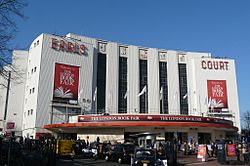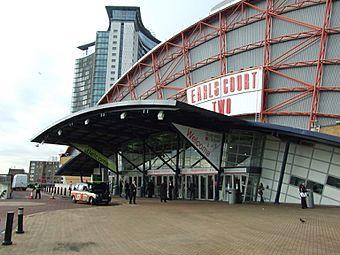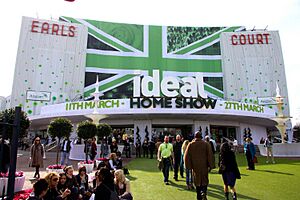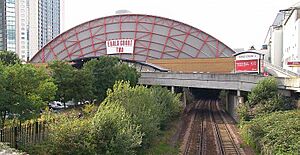Earls Court Exhibition Centre facts for kids
|
Earls Court One (1991–2014)
|
|

Earls Court Exhibition Centre in 2008
|
|
| Location | Kensington, Fulham, London, SW5 United Kingdom |
|---|---|
| Coordinates | 51°29′20″N 0°11′52″W / 51.48889°N 0.19778°W |
| Public transit | |
| Owner | TfL, APG and Delancey |
| Capacity | 20,000 |
| Surface | Versatile |
| Construction | |
| Built | 1935–37 |
| Opened | 1 September 1937 |
| Expanded | EC II in 1991 |
| Closed | 13 December 2014 |
| Demolished | 2014–2016 |
| Construction cost | £1.5 million (£74.7 million in 2021 pounds ) |
| Architect | C. Howard Crane |
The Earls Court Exhibition Centre was a huge building in London, England. It was a famous place for big shows, concerts, and events from 1937 until it closed in 2014. Many people remember it as a key part of London's event scene.
The centre was built between 1935 and 1937. It replaced an older entertainment area that started in 1887. An American architect named C. Howard Crane designed the new building. Sadly, the building was torn down between 2014 and 2017. Today, the area is still being redeveloped.
Earls Court was special because it was the biggest event venue in London. It was easy to get to, with two London Underground stations nearby. One station, Earl's Court tube station, even had a special tunnel for visitors.
Over the years, Earls Court hosted many famous events. These included the British International Motor Show, the London Boat Show, and the Ideal Home Show. It also held the Brit Awards for music and the famous Crufts dog show. It was even used for the 1948 and 2012 Olympic Games.
History of Earls Court
Before 1887, the area known as Earl's Court was mostly farmland. Then, many railway lines were built, creating a triangle of unused land. An entrepreneur named John Robinson Whitley saw an opportunity. He turned the land into a showground for five years, starting in 1887.
Whitley's idea helped shape the future of Earls Court. Later, another show organizer, Imre Kiralfy, built the Great Wheel there in 1895. This was a giant Ferris wheel. Kiralfy also built the Empress Hall, which could seat 6,000 people. Even Queen Victoria sometimes visited the shows!
Building the Exhibition Centre
In 1935, the land was sold. The new owners wanted to build a modern exhibition centre. They aimed to make it bigger and better than any other in the world. The goal was to create Europe's largest building by volume.
The project faced some challenges. It cost more money than planned and took longer to finish. Finally, designed by C. Howard Crane, the new Earls Court opened on September 1, 1937. Its first event was the Chocolate and Confectionery Exhibition.
The Famous Pool
One amazing feature of Earls Court was its huge indoor pool. This "lake" was 60 meters long and 30 meters wide. It took four days to fill and four days to empty, using millions of gallons of water!
When not in use, a 750-tonne floor covered the pool. This floor could be lowered using water power. The pool was used for boat shows and even for the Ideal Home Show until 2011.
A special entrance to Earl's Court tube station was built for the centre. It made it easy for visitors to arrive directly from the Underground.
Earls Court Two Expansion

Entrance to Earls Court Two, 2009
|
|
| Location | Kensington, London, SW5 United Kingdom |
|---|---|
| Owner | Capital and Counties Plc |
| Capacity | 10,750 or 6,000 (seated) |
| Construction | |
| Opened | 17 October 1991 |
| Closed | 13 December 2014 |
| Demolished | 2015 |
| Construction cost | £100 million (£218 million in 2021 pounds ) |
In 1985, the owners decided to make Earls Court even bigger. They wanted to compete with other large venues like the National Exhibition Centre in Birmingham.
So, they built Earls Court Two over the railway lines. This new hall cost £100 million and opened on October 17, 1991. It had a huge, column-free floor of 17,000 square meters. Princess Diana officially opened the new hall. After this, the original building was sometimes called Earls Court One. Earls Court Two was torn down in 2015.
Closure of the Centre
Over time, fewer people were visiting Earls Court. In 2008, the owners started making plans to close and demolish the centre. These plans were approved in 2013.
Demolition work began in December 2014, shortly after the centre closed. The last public event was a concert by the band Bombay Bicycle Club. The site has been derelict since then, meaning it's empty and unused.
Events Held at Earls Court
Earls Court hosted countless events, from trade shows to concerts. It was a central hub for entertainment and business in London.
Exhibitions and Shows
Many popular exhibitions took place here:
- The British International Motor Show (Earls Court Motor Show)
- The Ideal Home Show
- The BRIT Awards (music awards)
- The MPH Show, a big car exhibition with hosts like Jeremy Clarkson.
From 1950 to 1999, Earls Court was home to the Royal Tournament. This was the world's first and oldest military show. Hundreds of military personnel would stay on-site for about two months.
The PLASA Show, for professional lighting and sound, was held here for many years. The London Film and Comic Con also grew so popular it used both Earls Court 1 and 2.
Past Exhibitions
Some historical exhibitions included:
- The American Show, 1887
- The Italian Exhibition in London, 1888
- French Exhibition, 1890
- German Exhibition, 1891
- Empire of India Exhibition, 1895
- Greater Britain Exhibition, 1899
- Paris in London, 1902
- International Fire Exhibition, 1903
- Shakespeare's England, 1912
Boat Shows
The large pool in the main hall was perfect for boat shows. The London Boat Show was held there every year from 1960 to 2003. It was also used for the Earls Court Boat Show in 2007 and 2008.
War Refugees Camp
During the First World War, Earls Court helped many people. From 1914 to 1919, the exhibition grounds became a huge camp for over 100,000 Belgian refugees.
Sports Events
Earls Court was a major sports venue.
- In 1938, it hosted the first game played outside North America by a major professional sports league, with the Detroit Red Wings and Montreal Canadiens ice hockey teams.
- Professional wrestling events, including WWE shows, drew thousands of fans.
- It hosted the volleyball competitions for the 2012 Summer Olympics.
- For the 1948 Summer Olympics, it held boxing, gymnastics, weightlifting, and wrestling events.
- The 2010 FIFA World Cup Trophy Tour also stopped at Earls Court Two.
Musical Events
Earls Court was a very popular place for concerts. It could hold about 19,000 people.
- Bands like Led Zeppelin, Queen, and Pink Floyd played many sold-out shows there.
- David Bowie's 1978 concert was even released as a live album.
- Genesis filmed their "The Way We Walk" concert video there in 1992.
- Oasis held some of the biggest indoor gigs in Europe at Earls Court in 1995.
- Westlife performed concerts as part of their World of Our Own Tour in 2002.
- Iron Maiden played sold-out shows in 2000, 2003, and 2006.
Pink Floyd Seating Incident, 1994
During a Pink Floyd concert on October 12, 1994, a section of seating collapsed. About 1,200 people were in that section, and 90 were injured. Luckily, no one died. The show was cancelled and rescheduled.
Spice Girls Incident, 1999
The Spice Girls performed several concerts in December 1999. After their last show, on December 16, a worker sadly died from a fall while taking down the stage.
Brit Awards
The Brit Awards, which celebrate British pop music, were held at Earls Court several times. They took place there in 1996, 1997, 2000, and from 2006 to 2010.
Dog Shows
Before moving to Birmingham, the famous Crufts Dog Show was held annually at Earls Court. Another show, Discover Dogs, was also held there. It taught people how to best care for their dogs. The last dog show in London was in 2014.
Demolition and Redevelopment
The owners of Earls Court decided to demolish the centre and build new homes and shops. They planned to create up to 8,000 new apartments and retail areas. This huge project was expected to take many years.
Demolition work started in December 2014. The site is currently empty and awaiting new construction.
Opposition to Demolition
Many people were against tearing down Earls Court. A group called the 'Earl's Court Area Action Group' started a 'Save Earl's Court' campaign. They were worried about the impact on local residents and businesses.
Some people, like Darren Johnson from the Green Party, argued that the demolition would be a "disaster." They believed it would mostly benefit wealthy developers, not the community. Despite this opposition, the redevelopment plans were approved in 2013.
Future of the Site
In November 2019, the owners sold their share of the Earls Court site for £425 million. The new owners are a Dutch pension fund called APG and a British firm called Delancey. The site remains derelict as of 2025, with future plans still being developed.
See also
 In Spanish: Centro de Exhibiciones Earls Court para niños
In Spanish: Centro de Exhibiciones Earls Court para niños
- John Robinson Whitley
- Imre Kiralfy




